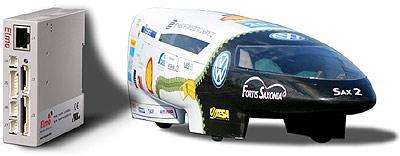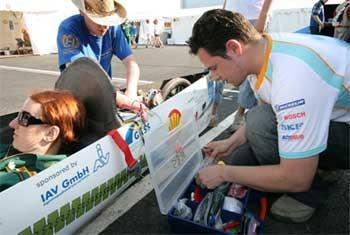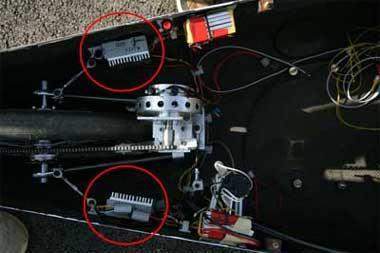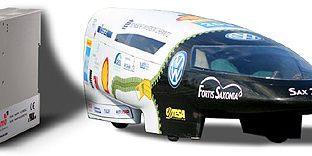Background
Some of the advantages of steer by wire technology are clearly apparent, as demonstrated in the Shell Eco-marathon, an energy-saving competition. The goal of the Shell Eco-marathon competition is to build a vehicle with the highest possible fuel efficiency – a car that can cover the greatest possible distance on a single liter of fuel. To do well, the vehicle design must be optimized and streamlined to reduce all conceivable sources of energy loss. With this goal in mind, an electronic steering system enables optimal use of space in the vehicle.

With Elmo Servo Drive Inside, the www.fortis-saxonia.de team reached 5th place at the Shell Eco-Marathon in 2007, achieving 2552 km on only one liter of petrol fuel
Advantages of Electronic Steering Systems
Electronic steering systems (steer by wire, SbW) are valued in the field of car manufacturing due to their flexibility and the mechanical decoupling of the chassis. Removing the standard steering column from the design and manufacturing equation simplifies interior design, reduces costs and reduces the requirements and processes of accident prevention and safety testing.
Technical Description
For the competition, Fortis Saxonia e. V. Chemnitz developed a new fuel cell vehicle, the Sax 2, which started in the prototype category.
Elmo Motion Control GmbH sponsored the Sax 2 eco car project at the Chemnitz University of Technology (CUT) and provided the team with Elmo’s Harmonica compact servo drivers. Two Harmonica mini servo drivers controlthe rear-wheel steering system of the Sax 2.
The standard steering column was replaced by a driver-controlled analog joystick which sends signals to the Harmonica servo drivers used to control the back wheel of the Sax 2.
One of the main advantages of SbW technology is the small amount of space that is required for moving the joystick. Maximum flexibility is achieved by placing the joystick in the cockpit, which also allows for a very narrow chassis design: In turn, the narrow chassis minimizes the front surface and air resistance.
The angle and speed of turning the “steering wheel” is dependent on the actual speed of the vehicle, but because the center of gravity of the Sax 2 is very high, the danger of rollover due to a steering fault or error has been minimized via SbW. Additional software was used to reduce the risk of the vehicle overturning.
The overall system is powered by a hydrogen fuel cell system.
The implementation of a Stability Control Sensor is planned for the future.

The Challenges
The highest possible level of function and flexibility is obtained with SbW technology. The implementation of additional software functions is possible and the software can be upgraded relatively quickly.
In order to improve safety and system availability, danger and fault tree analyses were carried out. The system was designed with built-in redundancies.
As mentioned previously, the Sax 2’s high center of gravity and the increased danger of rollover required unique solutions from the project design team. Additional challenges were the strict requirements for the weight and overall size of the motion controller and servo motors. Furthermore, high operational power with lightweight engines was an ever-present requirement.
The Elmo Solution
To improve safety and system availability, danger and fault tree analyses were carried out. Elmo’s Harmonica servo controller met all of the requirements for the SbW design presented in the technical description. The system was designed with built-in redundancies: Two redundant Harmonica motion controllers receive steering signals from the driver’s joystick and communicate velocity and position data to the rear wheel of the Sax 2.

Why Elmo:
- Short development time: Elmo products offer proven advanced control algorithms and hardware.
- High performance, excellent accuracy and repeatability.
- High level of dependability and functionality.
- Very high level of compactness and small volume was ideal in this application.
- High level of efficiency was very important in this application and helped reduce battery weight.
- Standard interface allowed quick and easy integration with other system components.
- Easy to program. No major restrictions in programming functionality.
- Good and prompt technical support. The support team was always reachable and available.

